Because there are so many questions about Wicca and how long it has been around--I found this on the internet and wanted to share it.
*************************************************************************************************
An Introduction to Wicca
~Kyle Lewis, January 2005
I'm writing this because the situation often comes up where people ask me what it is I practice. Sometimes we don't have time in the moment for a long conversation, and I've yet to find a single FAQ on a website which does a good job of illustrating Wicca to my satisfaction. I will also attempt to answer why I chose this at the end. So here it is... the 10,000 mile overview of Wicca with my spin on it, as down to Earth as possible.
What is Wicca?
In a nutshell, Wicca is a religion that celebrates both human fertility (sexual) and natural fertility (harvest) experiences through the changing of the seasons, the mysteries of the internal human psyche, the interconnectedness between the human inner life and the natural outer life of the Earth, and is based predominantly in European cultural myths that have been reinterpreted through modern romantic and inspirational writers.
Which Witch is Which? Are Wiccans Witches? Are Witches Wiccans?
Now, this is actually a controversial question in the craft community. Original British Traditional Wicca holds that Wiccans are Witches, and that to be a Witch, you have to be initiated by another Witch, and that Wicca is the religion that a Witch practices. Today's Wiccans don't all see it that way.
Truthfully, the word Witch is older than the religion of Wicca, and the history of the term is too long and complex to address is a document such as this, since my focus is specifically Wicca, and not the larger phenomenon of Witchcraft. For the purposes of this text, Wicca is a specific religious practice, of which its priesthood calls itself Witches. However, not all Witches are Wiccan, in that not all those who could be called a Witch follow the religious practice of Wicca. There are some who might argue that not all Wiccans are Witches--and this quickly becomes an argument of mere semantics.
For our purposes, from here on out, I will use the terms interchangeably. When I refer to a Witch, I mean someone who has embraced the Wiccan path.
What are Wiccan Beliefs
Well, the greatest belief held by Wiccans is that folks are free to define there own beliefs. In that sense, I would say that Wicca is a practice, not a belief, which involves celebrating the myths of the Esbats and Sabbats. That being said, there are common beliefs that are held by most Witches. The following is just a quick summary of some typical beliefs.
Deity: There is only One. The One expresses itself through masculine and feminine, and this polarity can be seen throughout creation. These two we call the Goddess and God. All Gods are but different faces of one God, all Goddesses different faces of one Goddess. The Gods are transcendent, but also immanent, found within us and the world around us. There is a lot of leeway in people's understandings of the Gods and how they work in our lives. Wicca is not a dogmatic religion, so it does not tell its practitioners they have to believe in the Gods in a particular way. Individual Wiccans are encouraged to experience and discover for themselves what it means to have a relationship with the Divine. To some, the Gods are very alive, and real, and have personal relationships with their followers. To others, the Gods are personified characteristics we place on primal natural forces so we can related to them. To others, the Gods are "merely" symbols for deeper psychological Archetypes, a la Karl Jung. Our common symbol of the Goddess is the moon, and our common symbol of the God is the sun.
Reincarnation: most Wiccans believe that when we die, we go to a resting place which we call the Summerland where we are reunited with loved ones and those who have gone before. When the time is right, we return to this world, to be born again by reincarnation. Some Wiccans believe we do this until we are perfected and no longer need to come back and learn life's lessons--a version of the Eastern concept of karma. Again, Wicca is not dogmatic, so there is no requirement to believe this... but it is a common occurrence in the community and the myth cycles that are enacted reflect this concept.
Goddess and God: Wicca holds that Divinity expresses itself as the duality of female and male. Each divine principle is personified as Goddess and God, and cultural deities are held to be expressions of them. Reality is seen to be the interplay of the relationship between the Two. Some Wiccans tends to be Goddess centric, and place the role of the woman above the man, as a direct response to the predominant patriarchy. Some Wiccans, like myself, see Goddess and God as co-equal, simply two halves of a greater whole, and so too the role of woman and man, with neither being elevated above the other.
Ethics: The standard law is, as long as it harms none, do as you will. Some take this as a free license to do whatever. However, this imposes more responsibility on the individual person, rather than less. It takes a great deal of wisdom to understand the impact of one's actions, and whether you're causing harm on a physical, emotional, mental or spiritual level. Everything boils down to a choice, and we all must take responsibility for those choices. Included in this is an implied imperative to discover what one's will actually is. This is done partially by attuning oneself to the Gods through ritual. There is also a traditional saying that what we put forth, good or bad, comes back to us threefold, especially where magic is concerned. This is a traditional saying, and not all Wiccans literally believe the three-fold multiplier effect. Yet, it's a good rule to keep in mind.
Sexuality: Wiccans celebrate and revere sexuality as an expression of divine joy and love. There is no stricture against sexual expression outside of marriage. Sexual ethics fall back upon the law of harm none, and again, this is a good example of where it takes a mature and responsible person to venture into this area. Wiccan rituals, as would be expected in a fertility religion, are filled with sexual symbolism.
Nature: Wiccans revere nature and the planet. Some worship the planet as a manifestation of the Goddess. Some see the immanent presence of Divinity within everything. Others simply recognize our inherent interconnectedness, and the importance and of caring for the world we live in.
Magic: Wiccans see magic as a natural part of life that we participate in, whether consciously or unconsciously. We strive to consciously participate in our interconnectedness with the world around us, which means we seek to develop and practice the magical and psychic arts, as healthy growth of our own inner beings. Magic, including the casting of spells, is a part of our culture.
Common Recurring Themes: Wiccans assert that the basic nature of reality is joy (ie, because the Gods are good, their manifestations are good), that the only constant is change, that we are continually growing and evolving into something greater, and that everything is cyclic. These themes recur throughout Wiccan belief, symbolism and practice. It should be noted that "good" doesn't always mean "pleasant". Wicca acknowledges that death and destruction as just as much a part of nature as life and birth. While those aspects are not always pleasant to experience, they are still good in that they are a necessary and natural part of the cycle.
Freedom: Wiccans do not believe that Wicca is the only path, nor even the best path for everyone. There are many paths to Divinity, and the relationship with Deity is a very personal one. Wicca is not for everyone. There are many roads to the center... this is simply the one we choose to follow. Wicca has no doctrinal imperative to convert anyone.
Historical Flyby
Wicca began in the early 1900s, drawing upon mythical reinterpretations of Robert Graves (The White Goddess), Sir James Frazer (The Golden Bough) and the academically suspect theories of Margaret Murray ("Witch Cult in Western Europe" and The God of the Witches).
The fundamental myth of Wicca is that there is one divinity that expresses itself through the polarity of Female and Male--the Goddess and Her consort, the God, and that their interplay is immanent throughout all of nature. The White Goddess is the being behind all Goddesses throughout history, and presides over the cosmos and the Earth. The Earth is a manifestation of the Goddess. Her consort, the Horned God, is a God of nature and passion, and is also a sacrificial harvest God, dying in the Earth so that his seed may grow into grain and be harvested. The Goddess is commonly represented by the Moon, linking her to inner mysteries, dreams, and the psychic world. The God is represented by the Sun, and so is directly linked with the harvest, but is also, through Classical sources, linked to concepts such as rational and analytical thought. Through the eight holy days (Sabbats), throughout the cycle of the year, the mysteries of the love affair between Goddess and God are celebrated. Wiccans originally mis-asserted that these myths were the original myths of Paleolithic fertility cults, as many readers took the work of Graves and Frazer to be anthropological rather than poetically inspired.
In addition to adopting the Gravers-Frazer mythos, it was also popularly believed that there was a secret organized Witch cult that had been heavily persecuted by the Church, gone underground, and survived in secrecy during the ages. This thought was only strengthened in popularity in Britain (the source of Wicca) because of a common fascination with secret societies in general, from the Knights Templar to the Rosicrucians and Freemasons. . Murray was an Egyptologist, but was more well known for her theories on the existence of a pre-Christian pan-European Witch cult. Murray's academic theories are suspect because she is seen to bend data to suit her theories, and used Frazer as a source, who in turn has been rejected by modern anthropologists.
In summary of the above, Wicca is one manifestation of England's late 1800s and early 1900s popular obsession and romanticization of rural, pastoral England. It was popular to believe that pastoral England was pristine, a remnant of earlier, more perfect times. Wicca is just one example of this popular notion crystallizing. Frazer's Golden Bough is another. Another, well known example of this occurs in Tolkein's Lord of the Rings.... the Shire is romanticized rural England, contrasted with Saruman's and Sauron's spreading industrial cities and the urban machines of war.
Gerald Gardner is the father of modern Wicca. He took the myths of Graves and Frazer, the belief in an ancient Witch cult, and his own training in Western Ceremonial Magic (from the teachings of Crowley, heavily influenced by sources like Kabbalah and societies like Freemasonry), and created the first Wiccan coven. It went through many refinements as it progressed through the decades.
At first, Wicca was highly secretive and rigid in its traditions, following a strict matriarchal hierarchy. Those traditions still exist today, but as Wicca grew, some of its members took its secrets and reshaped it, until it eventually made its way to the Americas and underwent a protestant revolution of sorts as it was transformed by the '60s political counter culture. Many strains of Wicca became less rigid and more eclectic in its approach, allowing for self-initiations and thumbing its nose at the British Traditions. Today, a rift has grown between the two. On one side you have traditional initiates who do not recognize the legitimacy of anyone not initiated by someone from within those traditions. At the other extreme, you have Wiccans who say none of that is necessary and have no hierarchy or structure. And of course, there is a full spectrum of opinion in between. I tend to fall somewhere in between.
How old is the Craft?
The cultural myth asserts that Wicca is about 20,000 years old, inheriting directly from the ancient Paleolithic lunar fertility cults. This, however, is only Myth. Wicca as we know is was created by Gerald Gardner in the early 1900s over a period of several years as he refined a practice from various sources, including the romantic myths of Fraser and Graves to Medieval Ceremonial Magic.
But it should be remembered that all myths grow and change with time. While Wicca is a new practice, it inherits from old pre-Christian (and also from Christian) sources.
The outer form is new and evolving. Its mysteries are ancient.
What is the Wiccan Experience?
All religions seek to have it's practitioners experience the divine in some way. Wicca asserts that we are all part of an interconnected natural world, and so too are the plants, animals, and even the land, air, and see itself. Wicca sees Divinity as both immanent and transcendent. The Gods are greater than us and our world, yet they too are equally present, both within the world around us, and also within ourselves.
Wiccans use dramatic enactment of myth through ritual to express this reality through symbolic action. The goal is to experience that interconnectedness and live with it as opposed to live in spite of it. It is to this end that the holy days are celebrated, timed to the cycle of the Moon and also to the Sun through the changing of the seasons. (The Moon is a symbol of the Goddess and the Sun a symbol of the God.)
Wicca recognizes that reality extends beyond what we can sense with our five physical senses. The belief in, active development of, and practice of the psychic and magical arts is simply a recognition of this greater reality in conjunction with recognizing our inherent interconnectedness with the world around us.
How do Wiccans celebrate? What are the holy days and what are Wiccan services like?
Wiccans have two kinds of holy days: Esbats and Sabbats. Esbats--which occur every full moon--celebrate the lunar cycles, and Sabbats the solar and harvest cycles. If you were to draw an analogue to mainstream Christianity, our Sunday equivalent--that is our regular recurring gathering--occurs monthly on the Full Moon instead of weekly. These are the Esbats. Our eight Sabbats are the holidays, the feast days, which are analogous to, and in fact sometime the source of, many Christian holidays.
A Wiccan group that meets to worship and learn together is traditionally called a coven. The coven meets every Full Moon for the Esbat. The usual practice is to open the temple according to the tradition of the group. The actual ritual will vary from Full Moon to Full Moon, depending on the needs of the coven and the direction of coven leadership. Sometimes there will be guided meditation. Sometimes Coven business is discussed. Sometimes there are lectures given, and sometimes magic is worked. There are also other rituals that can be performed, myths that are enacted that happen outside the context of the Sabbat year-cycle myth.
The Sabbats celebrate two things: the astronomical progression of the Sun through the year, and the times of harvest. The myths of Wicca come from a time when the life of an individual was much more dependant on the community and the harvest, which means life was tied to the cyclical changing of the seasons. Summer was a time of joy and warmth; fall the bounty of the harvest; autumn the time of reaping the harvest in preparation for the cold, dark winter months; and spring the sewing of the seed in the ground.
There are eight Sabbats. Four are called "minor" Sabbats, which fall on the equinoxes and solstices. It is believed that these were borrowed from the Druids (a solar tradition) and adopted by Witches (lunar/fertility tradition). The "major" Sabbats are held to be native to the ancient fertility cults, and would have fallen at times based on the harvest. Today, they fall halfway in between the equinoxes and solstices, so that the eight holidays are evenly spaced throughout the year.
Yule (~22 Dec, Winter Solstice. Pronounced YOOL) There are several mythological themes here. This is the solstice, which is the transition time from waning to waxing year. The God of the Waning year is the Holly King, who rules from Midsummer to Yule. At Yule, he has reached the height of his power. The day is darkest, the night is longest. The Sun is dead. At Yule, he is usurped by his brother, the God of the waxing year, the Oak King. The year moves from waning to waxing, and light is born into the world again. The Sun is reborn as a child. This is the birth of the Sun, and is a precursor to Christmas. The Goddess presides over all this transition, ruling in her Life in Death aspect. The Wheel of the Year turns.
Imbolg (1 Feb. Pronounced Im-MOL'g') Later Christianized as Candlemas. This is the festival of lights. Literally meaning "in the belly [of the Goddess]", Imbolc is the first glimmer of promise of the warmth and light of spring. The theme is hope, having passed through the darkness of winter. This theme of the end of winter is echoed today in Groundhog Day. Bride/Brigidh is a patron Goddess of this day.
Spring Equinox (~22 Mar, Spring Equinox) Also called Ostara by some. Precursor to Easter. Here, the year is in perfect balance--day and night are equal in length and we move into the light half of the year. The egg is a symbol of this Sabbat, a symbol of promise, life and fertility. This is a time of planting, so the fertility theme here is primarily agricultural. The theme here is also cosmic balance, between light and dark... stillness, but poised for action. This is a time for magic aimed at making the earth fertile, so crops will grow.
Bealtaine (1 May. Pronounced Byol-tinnuh, or Byal-tinya) Sometimes celebrated 30 April, anglicized to Beltane. May Eve. This and Samhain are the two most important Sabbats and highly celebrated to most Wiccans. Whereas Spring Equinox is about agricultural fertility, Bealtaine is most definitely about human fertility and the joy of human sexuality. This is a fire festival, and the bon fire, or Bel fire, is a symbol of this time, as is the maypole. Celebrated here too, is the ritual sacrificial mating of the Oak King with the Goddess. Through mating with her, he dies and is reborn. Bel is a patron God of this day.
Midsummer (~22 Jun, Summer Solstice) Sometimes called Litha, or even a second Beltane, is also a fire festival, but it's fire and water. Here the Sun is at its greatest power. Here too, the Oak King ends is reign and is usurped by the Holly King, as we move from waxing to waning year. The Goddess presides in her Death in Life aspect, reminding us that everything changes, nothing is static. What comes to be will fade, and what fades will eventually come to be again.
Lughnasadh (1 Aug. Pronounced Loo-NAH-sah) Sometimes called Lammas, or Loafmas. Another light festival, but where Bealtaine was about Bel, Lughnasadh celebrates Lugh. Both are Light/Fire Gods. This is also the first harvest and so is a feast of thanksgiving. Here too is the sacrificial death and resurrection through mating of the Holly King, as Bealtaine was the Oak King. Lugh is a patron God of this day.
Autumn Equinox (~22 Sep, Autumn Equinox) Also called Mabon by some. Just as with Spring Equinox, this is a time of balance between light and dark. But the focus is different this time. This is the equilibrium and calm of rest after labor. This is a second feast of thanksgiving, and rest after the summer's work. Some of the themes from Sabbats overlap (like thanksgiving, and the two Beltanes), probably because the greater and lesser Sabbats came from different traditions and were adopted together.
Samhain (31 Oct. Pronounced SOW-in.) The harvest is done, and the winter is nigh. We enter the darkest part of the year. This is a time for feasting and love-making as a positive affirmation of life in challenge to the winter ahead. By now, all the crops should be harvested, or tradition holds they will be spoilt by evil spirits. This is the end of the year and the beginning of a new one, the Wiccan New Year. On this night, the veil between the worlds is thin, and it is a time to remember those who have gone before, our ancestors. It is a time for scrying, divination and spirit communication. Of course, this later grew into All Souls Night to reflect on all the saints in heaven and the more mundane Hallowe'en with its ghosts. Samhain is concerned with death, yet it is also a serious reaffirmation of life. Wicca, after all, embraces the mystery of reincarnation, that that which dies shall be reborn.
What is the social structure in Wicca?
Typically, Wiccan groups tend to be small, autonomous units called covens. Traditionally a coven is not supposed to be larger than 13 members. However, I've found that 10 members is on the large side. Oftentimes, a group might be even smaller... a working couple, a family, or as is more common nowadays, a solitary practitioner trying to learn the path individually through study, trial and error.
What would I expect to see visiting a Wiccan circle?
Typical rituals follow a simple format: opening, body, and closing. Opening and closing rites often are the same from ritual to ritual, or very similar. They follow a standard pattern of inviting the members into the sacred space, casting a circle to magically separate the mundane world from the sacred temple, and welcoming and inviting the spirits and guardians of the four cardinal compass directions (usually the four elements) and inviting or invoking the deities.
The altar is usually either in the middle of the circle to the North or East. Traditionally, it would be in the North, which is the quarter for Earth, since Wicca is an Earth-based religion. Members are invited in and consecrated with oil. The ritual leaders cleanse the sacred space with water and incense, cast the circle, lead the coven in calling in the quarters and divinity, and then lead them in raising energy of some kind. Typical methods of raising energy include dance and chant. Oftentimes, there will be a prepared mixed CD of music playing in the background to add to the mood. Mood and atmosphere is very important.
Once the opening rite is performed, then the coven either performs whatever magic it needs to perform, or reenacts a myth, such as at a Sabbat. After the body of the ritual is performed for that occasion, the flow falls back into a standard format of sharing a meal... "cakes and ale", which involves consecrating wine (or another drink) and some sort of bread. At a Sabbat, after this, there is a great feast, and joking and visiting with each other, all still within the sacred space of the consecrated circle/temple.
Once the meal is done and visiting draws to an end, the leaders will then gather the focus of the coven, dismiss and thank the quarters and the deities, and then banish the circle, rejoining the sacred space and the participants therein back to the normal flow of life around.
Probably the most shocking thing to a non Wiccan encountering circle for the first time is the distinct use of pagan God names, and no mention of Christ. It's shocking, only because it's so different from what is normally encountered in our present day society. There are no sacrifices or violence... nothing that one might typically mistakenly suspect when they hear the word 'witch'. There is, however, sexual symbolism which may put some at unease at first. (Consecrating the wine involves plunging the blade into the chalice as a symbolic sexual act, joining the male and female principle.)
Don't Witches run around naked?
There is traditional precedence in Wicca for rituals to be performed in the nude, even in congregation. The term for this is "skyclad". There are valid traditional and magical reasons that a coven might choose to honor this tradition. However, the majority of covens today do not practice skyclad, but instead work robed. There are also valid reasons, both mundane and magical, to work robed. When I trained for a time, my Lady was married to a non Wiccan, as was I. So of course, everything was "above bar" and robed.
Do witches have sex in ritual?
It is common practice to symbolize, through the use of ritual tools such as the chalice and the blade (athame), the mysteries of sexual polarity and union. This rite of sexual union is called the Great Rite.
On rare occasion, the Great Rite might be performed in actuality, with the priest and priestess actually making love. However, traditionally this is supposed to only happen between partners who are already in an intimate loving relationship, and in private. It is said that "sex magic without love is black magic." If in a coven setting, the coven leaves the room before this would occur to allow the couple privacy for their love-making.
It is not part of Wiccan practice for coven leadership to use sex as a requirement for initiation, or try to break people's oaths of fidelity. Part of learning magic is cultivating a sense of honor and integrity, especially for the spoken word--oaths. Wiccans place a high value on oaths, and would be loath to be a part of someone breaking their marriage oaths to another.
Unfortunately, as is true with ANY religion, there are practitioners who do not live up to the standards set forth by the path. One only has to look at the child abuses committed by Catholic priests to see this. It is sad that sexual predators exist in Wicca as well. If one can observe the crimes committed by the Catholic priests and recognize that these men and acts are not representative of the teachings and spirit of the Church, then one too can separate such acts from the path of Wicca as well.
Basically, if you're a student seeking a group, and you feel that there are sexual pressures, get out and find another group!
Relationship to Christianity?
The relationship between Christianity and Wicca is unfortunately not a friendly one. Christianity has never been friendly to competing religions, and this is only aggravated by the fact that the Church was also the political power at the time combined with doctrines of conversion built into its belief system.
When Gardner built his Craft, he believed in the Craft as a greater, hidden community that had been persecuted and run underground by the Church. While there is truth that the Church crushed competing religions and those who clung to it, wrapping his group-myth around this conflict started the movement in the context of the Christian inquisition framework. Aligning with the Witch concept and adopting that label also helped to add to the perception that Wicca is a tool against Christianity. In truth, it is not such a tool.
Wiccans does not worship the Devil. The Devil exists within the Christian mythos, and Wicca exists outside of that myth. Gerald Gardner, in adopting this Craft, wasn't rejecting a Christian God, he was rejecting the whole Christian paradigm, which includes the institutional Church, and also the Devil. Other pagan faiths using different labels, such as the resurgence in Druidry (more authentic, historic Celtic paganism) and Asatru (Norse/Germanic pre-Christian religion), don't quite bear the same stigma in Christian eyes as Wicca with its pentagrams.
Over the years, Wicca is slowly becoming more accepted and losing its negative stigma as a threat. Hopefully, in the future it will coexist peacefully beside Christianity, as simply another religious choice. This will only truly happen when Christians mature beyond the doctrine of conversion and the need to "be right" at the expense of others' ability to also be right. I fear this is a ways off yet.
Relevance to the modern world?
Is Wicca relevant? I mean, most of society is not longer tied to the cycles of harvest. The Winters are cold, but most of us are sheltered with the benefits of modern inventions like internal heating. To be fair, this is a good question. In the end, one has to decide for himself or herself whether this would be relevant to them or not.
A mystical worldview, by itself, does not make Wicca automatically relevant. There are many mystical traditions in the world, and most of them share common elements with Wicca (in fact, Wicca has borrowed from many sources, Western and Eastern). One can have a beliefs compatible with Wicca and not be Wiccan. The question becomes... is the practice of the Sabbats, the Wiccan mythical view of dynamic divine polarity, and the celebration of the harvest relevant?
For me, I find it relevant. I find Wicca to be a practice that embraces and fosters concepts like life through community, fruits through labor, family, hearth, and respect for each other and the land around us, and communion with the Divine in a way that reflects all of this. Whether it's farming or spell casting, we are reminded that humanity has the power to shape our surroundings, that our choices have real effects in the world, and with that comes responsibility. Through honoring the seasons and giving thanks for each other and sharing meals together, we are reminded that it takes a community to survive through the hard times. Even more so now, the food we enjoy is a result of a highly interconnected network of people. Through rituals, gatherings and myths that celebrate the Gods presence and love manifest in the land and natural world, we are reminded of our interconnectedness with the land--something that is easily forgotten today.
And, whether or not that pastoral countryside lives up to its romantic image, I find the ideal of hearth and home, kith and kin, something worth striving for, defending, and celebrating. The importance of such things are timeless, no matter what age you live in, no matter what technological advances have been made. And that, in the end, is what makes the religious practice relevant.
Sources
Most of the above is written from memory, as a synthesis of what I have studied and practiced, and opinions that have formed. However, below gives some of my primary sources of information that I rely on.
Triumph of the Moon, Ronald Hutton, April 2001: This is perhaps the best book on the history of Wicca. It examines how it developed, key founding personalities, and how it evolved into the American craft. This book is written from an academic perspective and does not support the views of Murray and Frazer.
A Witches' Bible, Janet and Stewart Farrar, July 1996: This is a good example of British Traditional Wicca (heavily Alexandrian influenced, with some comments on Gardenarian style). It also is written from a viewpoint where the myths and theories of Frazer and Murray are held to be true, especially in the chapters concerning the Sabbats.
Wikipedia (http://en.wikipedia.org): A great online source for many things. In writing this, I looked up the entry on Margaret Murray.
Copyright January 2005, Kyle Lewis
Welcome to my online Book of Shadows.
A good place to come and learn from and share with like-minded Pagans and Wiccans of all Traditions.
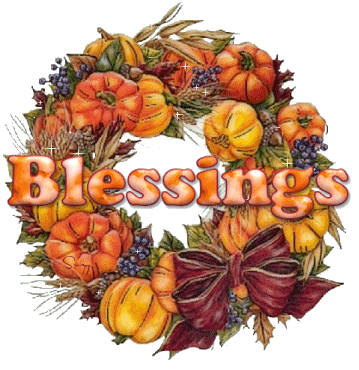
glitter-graphics.com

glitter-graphics.com
Wiccan Rede
Saturday, May 3, 2008
Subscribe to:
Post Comments (Atom)
Live Traffic Feed
Being

Breath

Courage

Fight for Freedom
Earth Air Fire Water
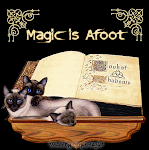
Talisman
Spellwork
Moon Goddess
Moon Phases
CURRENT MOON
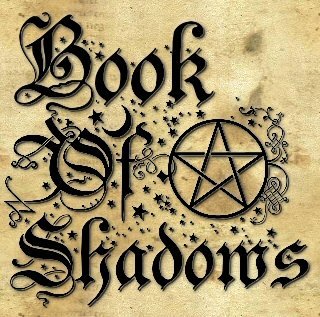





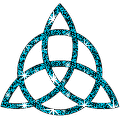
















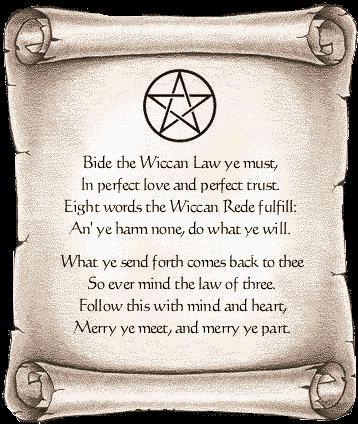








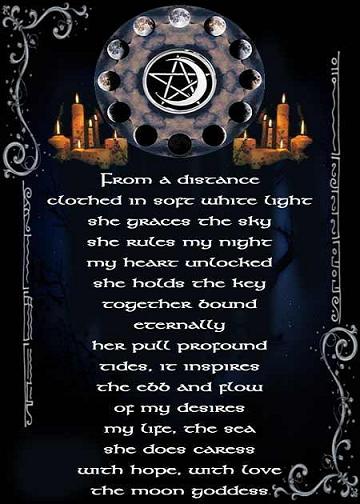




No comments:
Post a Comment